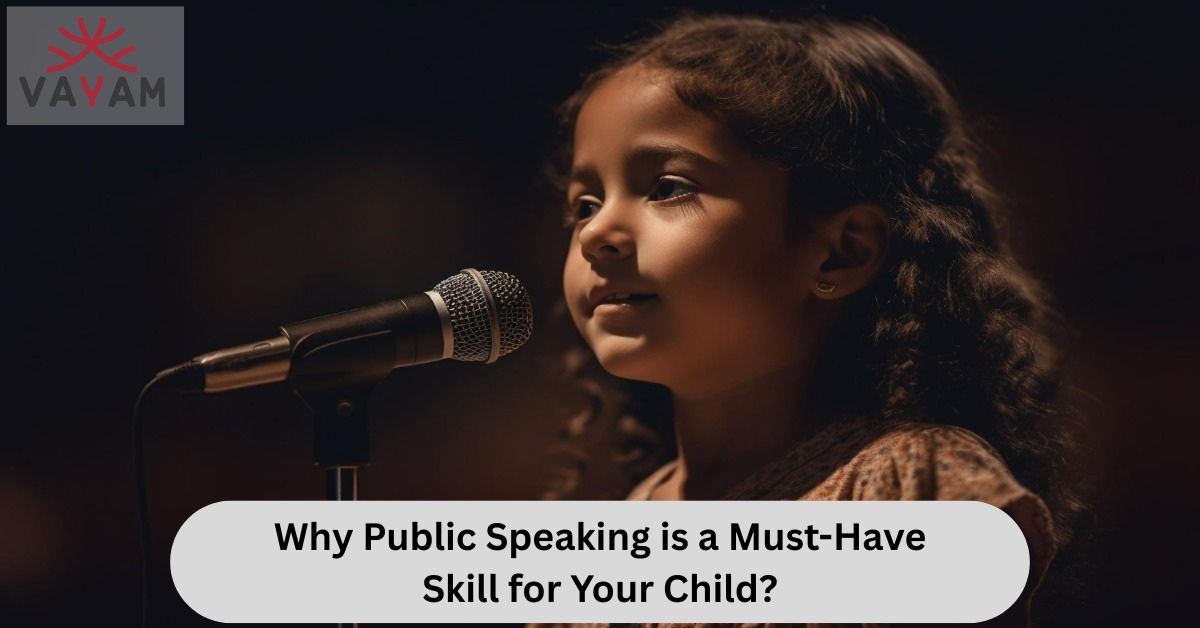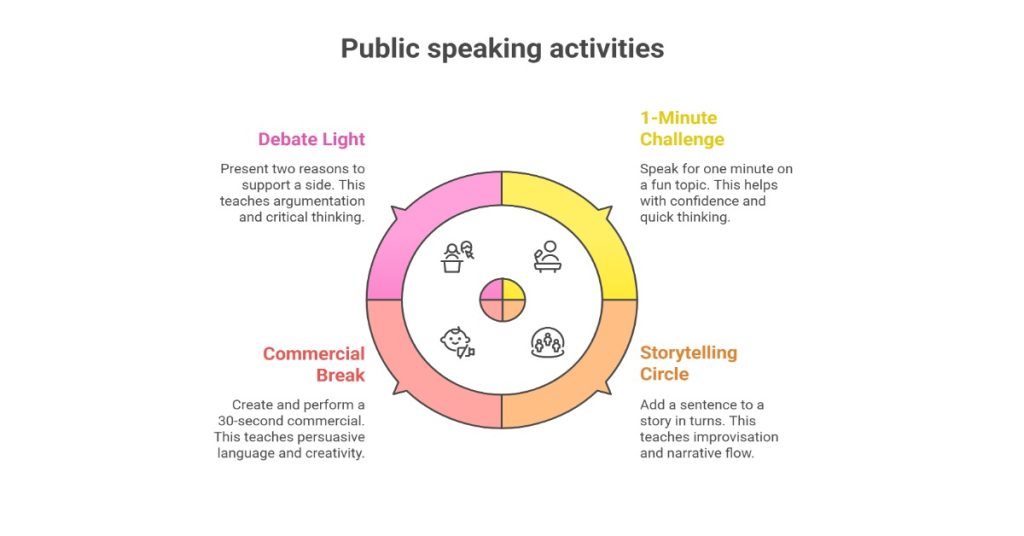
A child stands before their class, not with trembling hands and a shaky voice, but with confidence. They clearly share their ideas about a book they loved or a science project they’re passionate about. Their classmates listen, engaged. The teacher nods, impressed.
This isn’t a scene from a movie. It’s the tangible outcome of a critical, yet often overlooked, skill: public speaking.
We pour energy into teaching our kids math, science, and literature. We sign them up for soccer and piano lessons. But we often shy away from the one skill that ties everything together—the ability to communicate effectively. We dismiss it as a natural talent for the extroverted few. But that’s a mistake.
Public speaking is not about creating future politicians or motivational speakers. It’s about equipping our children with a foundational tool for life. It’s a superpower that builds confidence, sharpens thinking, and opens doors. Let’s explore why this skill is non-negotiable for the next generation.

More Than Just “Talking in Front of People”
When we hear “public speaking,” we imagine a stage and a large audience. For a child, their “public” is much smaller. It’s their classroom, their scout troop, or even just their family at the dinner table.
The goal isn’t perfection. It’s about learning to organize thoughts and present them coherently. It’s about finding their voice and having the courage to use it. This practice transforms them from passive learners into active participants in their own lives.
The benefits ripple out into every aspect of their development.
Building Unshakeable Confidence from the Inside Out
There is nothing quite like the feeling of conquering a fear. For many children, speaking up is a monumental hurdle. Each time they do it successfully, they score a victory against self-doubt.
This confidence isn’t just for the podium. It transfers to the playground, where they can assert themselves kindly. It helps them ask questions in class when they don’t understand. This self-assurance becomes part of their identity, encouraging them to take on new challenges they might have otherwise avoided.
Sharpening Critical Thinking and Organizational Skills
You can’t communicate an idea clearly if you don’t understand it yourself. Preparing a speech, even a short one, forces a child to structure their thoughts. They learn to identify a main point, gather supporting details, and arrange them logically.
This process is a crash course in critical thinking. They learn to distinguish between important and irrelevant information. They begin to anticipate questions an audience might have. These organizational skills are directly applicable to writing essays, solving complex math problems, and simply making sound decisions.

Enhancing Academic Performance Across the Board
The link between communication skills and academic success is undeniable. A child comfortable with speaking up is more likely to participate in class discussions. This active engagement deepens their understanding of the material.
Furthermore, presenting on a topic—whether it’s the life cycle of a frog or a historical figure—is a powerful form of learning. Teaching something to others is one of the most effective ways to master it. This “learning by teaching” cements knowledge far better than passive memorization.
Fostering Empathy and Leadership Qualities
Effective public speaking isn’t a one-way street. It’s about connecting with an audience. This requires a child to step outside themselves and consider the perspectives of others. What will my classmates find interesting? How can I explain this so everyone understands?
This cultivation of empathy is the bedrock of leadership. True leaders aren’t just those who speak the loudest; they are those who listen, understand, and inspire. Public speaking activities teach kids to persuade, to motivate, and to bring people together around an idea—the very essence of leadership.
Preparing for the Future, Today
Let’s be practical. The world our children will enter values communication above all. College interviews, internship presentations, team projects in the workplace—these are all forms of public speaking. A young adult who can present their ideas with clarity and poise has a significant advantage.
In an age of digital communication, the ability to connect face-to-face is becoming a rare and valuable commodity. Those who possess it will stand out. We are preparing them not just for the next grade, but for their future careers and communities.

Answering Your Questions About Public Speaking for Kids
As parents and educators, it’s natural to have questions about how to nurture this skill effectively. Here are answers to some common queries.
1. At what age should I start teaching my child public speaking?
You can start as soon as they start forming sentences. The key is to keep it age-appropriate. For a preschooler, “public speaking” might be describing their favorite toy to the family. For an elementary school child, it’s a short show-and-tell.
The goal in the early years is to make speaking a normal, positive experience. Don’t focus on criticism. Instead, celebrate their effort. The foundation you build in these early years will make formal training later on much easier and more effective.
2. My child is very shy. How can I help them without pushing too hard?
This is perhaps the most common concern. For a shy child, forcing them into the spotlight can be traumatic. The approach must be gentle and gradual. Start in a safe, private space. Practice with just you, then maybe with one trusted sibling or friend.
Use activities that feel like games, not speeches. Encourage them to read a story aloud with character voices. Role-play a TV interviewer and a guest. The pressure is off, but the skill of speaking is being practiced. Celebrate every small step and assure them that it’s okay to feel nervous.
3. What are some fun public speaking activities for kids at home?
Turning practice into play is the best strategy. Here are a few ideas:
- The 1-Minute Challenge: Have them talk for one minute on a fun topic like “Why my pet is the best” or “The ultimate ice cream sundae.”
- Storytelling Circle: Start a story with one sentence and have each family member add a sentence. This teaches improvisation and narrative flow.
- Commercial Break: Ask them to create and perform a 30-second commercial for their favorite snack or toy. This teaches persuasive language.
- Debate Light: Pick a lighthearted topic (e.g., “Pancakes are better than waffles”) and have them present two reasons to support their side.

4. How can I help my child overcome the fear of public speaking?
First, validate their fear. Tell them it’s completely normal—even adults feel nervous! Then, give them practical tools. Practice deep breathing exercises together to calm their body. Teach them to focus on one friendly face in the audience instead of scanning the crowd.
Most importantly, help them shift their mindset from “I’m performing” to “I’m sharing.” When the goal is to share an idea they care about, the focus moves away from their own anxiety and onto the message. Rehearsal is also key; familiarity with their material builds confidence.
5. What are the long-term benefits of public speaking for children?
The long-term advantages are profound. Beyond academic and career success, it shapes their character. These children grow into adults who can advocate for themselves and others. They can navigate difficult conversations with grace. They become critical consumers of information, able to analyze speeches and arguments.
Ultimately, they become more engaged citizens, unafraid to contribute their voice to their community. They carry with them a sense of self-worth and the ability to connect authentically with the world around them.
Read More
How to Encourage Kids to Dream Big and Set Goals?
Creative Ways to Teach Kids Public Speaking & Communication Skills
Unlocking Your Child’s Potential: A Parent’s Guide to Teaching Effective Problem-Solving
The Greatest Gift We Can Give
In a world that often rewards the loudest voice, let’s teach our children not to be loud, but to be clear. Not to be performative, but to be persuasive. Not to seek attention, but to command respect through the power of their ideas.
Public speaking is the vehicle for this. It’s the skill that turns knowledge into impact and anxiety into action. It’s not an extra-curricular activity; it’s a core component of a well-rounded education.
So, the next time your child wants to tell you a long, detailed story about their day, listen. You’re witnessing the first draft of a future speech. Encourage it. Nurture it. You’re not just building a better student; you’re building a more confident, articulate, and empowered human being. And that is a superpower that will last a lifetime.
